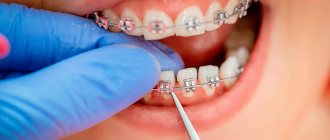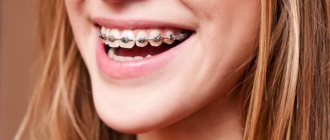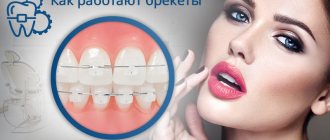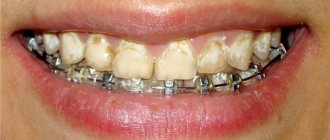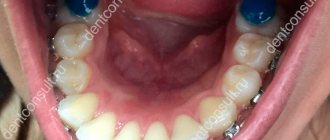Everything you would like to know about correcting your bite and straightening your teeth with braces.
Let's be honest: in modern realities, a beautiful smile is the norm, and it is necessary to get rid of dental imperfections. But, having set such a goal, it is desirable to have reliable information about existing methods and upcoming tests. We tried to collect in one article all the most important things about braces in order to save you from having to look for answers on your own on the Internet, where the truth is mixed with myths and advertising fluff.
Important!
In the article, prices are indicated for St. Petersburg and the Leningrad region.
How are braces different from aligners?
This question worries many: is it possible to pay more, but get by wearing transparent removable aligners? The truth is that nice aligners can only cope with minor problems (for example, with one tooth that has grown incorrectly), but only fixed structures - those same “ugly braces” - can create an orthodontic load to shift the dentition.
As for cap-aligners, to achieve the effect, it is recommended to wear them at least 22 hours a day, removing them only during meals. As practice shows, a person often violates such rules by being distracted, forgetting, or simply allowing himself some indulgence. Strictly speaking, aligners are not intended to correct bites, and if they are positioned as such on the clinic’s website, it is better to turn to other specialists.
And the financial point: you will have to pay not more for the aligners, but much more, because during the treatment period they need to be changed at least 15 times (and sometimes much more), so the average minimum cost of correction with the help of aligners should be considered an amount of about 250- 300 thousand rubles.
How to avoid?
Prevention of unpleasant consequences consists of certain actions:
- Maintain careful oral hygiene. The need for cleansing after each meal has already been mentioned above. During daily procedures, it is recommended to use dental floss, orthodontic brushes, and irrigators.
- Cleaning technique . During hygiene, you should not put excessive pressure on the enamel and gums.
- Elimination of self-removal of the structure. Even if there is a very compelling reason and a serious complication occurs, only a specialist should remove braces.
- Timely contact with the orthodontist . If you suddenly encounter a breakdown or damage to the structure, immediately seek help from a specialist.
It is important to follow all the doctor’s recommendations. This can include not only hygiene, but also nutritional rules, preventive visits to the dentist, and timely elimination of emerging problems.
The video provides information about the benefits and harms of braces.
Installing and wearing braces: does it hurt?
When installing braces, the vast majority of patients do not experience any noticeable pain, but discomfort certainly appears, and you will have to get used to the braces - for some faster, for others longer, on average - 1-2 days. The exception is, perhaps, people with a very low pain threshold or with increased impressionability - it is from them that the myths about the pain of installing and wearing braces come.
In fact, sometimes there is irritation of the mucous membranes of the lips and cheeks. To solve this problem, a special wax is used, which the doctor will definitely suggest after installation.
Myth No. 6. Psychological and social harm.
Some people think that braces can ruin their appearance and that they can’t smile with braces. A patient with braces should not worry about this. Long gone are the days when braces were perceived as something rare and repulsive. Consider it as part of your new stylish look. This is a kind of indicator of modernity. Moreover, in addition to traditional metal systems, you can install less noticeable ones - ceramic ones.
Knowing that your smile is getting better every day should be a rewarding experience throughout your treatment. It is necessary to remember that this is a temporary stage of life, and the result will be a beautiful and healthy smile.
Watch the video: “Myths about the dangers of braces”
I’ll take off my braces, a couple of years will pass, and my teeth will return to their place... is this true?
But this is true - but from the practice of past years! Now, after removing braces, the dentition is secured using a special non-removable retainer apparatus; previously this was not always done - hence the accumulated complaints. Today, orthodontists are required to install such a device.
A retainer is a thin wire that is installed on the inside of the front teeth and prevents them from moving apart. And this is for the rest of your life, but you shouldn’t worry: the delay is imperceptible, those around you don’t see it, and if it breaks, it’s easy to fix—just don’t delay your visit to the doctor.
Another problem is more pressing: sometimes, after straightening the dentition, previously hidden aesthetic defects (for example, different lengths of teeth) become noticeable. In this case, you will really have to resort to restoration or buy expensive veneers.
Important!
The orthodontist must notice such defects and warn the patient before starting treatment.
Restoring enamel after braces
The aesthetic consequences of braces can be successfully eliminated using the following procedures:
- professional cleaning;
- teeth whitening;
- installation of retainers with a special composition that strengthens the enamel;
- polishing and processing of enamel with special solutions.
Do braces damage enamel and lead to caries?
No, the tight fit of the braces completely eliminates the penetration of food debris and microbes into the tooth; Dental enamel glue used in practice is harmless, moreover, it contains the useful element fluorine. The brace-lock even protects the tooth in a certain way.
But improper care of braces is really fraught with trouble: oral hygiene after installation of an orthopedic structure requires more attention and responsibility due to the increased accumulation of plaque. And where there is plaque, there is caries!
Is it necessary to use additional products to clean braces?
On forums (and sometimes in the recommendations of “experts”!) there are numerous additional products that supposedly make oral hygiene easier in the presence of braces (rinses, ultrasonic brushes, etc.)
In fact, with a responsible approach, it is quite possible to get by with three basic tools (toothbrush, dental floss, brush). In this case, you should not rely on someone else’s opinion. The quality of care will be assessed by a doctor who conducts regular examinations, and he will also recommend additional remedies, if necessary.
How to brush your teeth with braces?
This is where a traditional toothbrush and toothpaste don't serve their purpose. Therefore, you will need to buy a special orthodontic brush, brushes and floss from the pharmacy. You can also use an oral irrigator if you wish.
This way you can effectively clean your teeth and the area around the locks. Teeth should be thoroughly brushed after each meal, because food debris is deposited on braces, which contributes to the development of caries and does not look aesthetically pleasing. We have repeatedly encountered patients whose teeth are more well-groomed than those of a person without braces.
Is there a need to give up your usual food?
As a rule, when installing a brace system, the doctor will actually announce “forbidden” foods, and this list looks quite depressing (cookies, chips, seeds/nuts, crackers, chewing gum, pizza, chocolate bars, etc. - everything that can stick to the structure , creating conditions for the proliferation of microbes, or damaging it). But in this case, the doctor’s recommendations should be approached in a differentiated manner: there is a clear reinsurance here, the only thing that is actually required from the patient is caution.
Is it true that sapphire braces are the best?
Sapphire braces are much more expensive than iron braces, but their advantages do not lie in the effectiveness of treatment. Moreover, in reliability they are inferior to metal ones. But on the teeth, such brace systems look much more aesthetically pleasing, since transparent brace locks are almost invisible.
Let us clarify: the precious natural stone sapphire has nothing to do with the production of such briquettes; we are talking about artificially grown crystals.
By the way, there are also cheaper transparent braces - ceramic (much more expensive than metal ones, but not as expensive as sapphires) and plastic designs. Only the former are too fragile and unstable in relation to food dyes (can lead to yellowing of teeth), and the latter are intended only for short-term use.
How much do simple metal braces cost?
The remarkable cheapness of hardware is just a myth supported by some clinics. Indeed, by indicating the cost of one element of the braces system, they create the illusion of affordable treatment, but the patient should understand that the treatment process involves paying for braces, dental materials, multiple visits to the doctor and various procedures, including removal of the system at the end of treatment - and all this will cost at a very decent amount.
On average, the price of a course of treatment in an ordinary case (healthy teeth, simple defect) is 150-170 thousand rubles. (and this does not take into account preliminary professional teeth cleaning and diagnostics). If you have tooth decay and/or gum problems, you should add the cost of treatment or surgery to this amount. After removing the braces, you will have to pay for the installation of retainers, and, if necessary, restoration or installation of veneers.
Important!
There is no point in finding out the cost of braces over the phone, since each case is individual; choose the clinic where they will tell you the amount of all necessary procedures and operations - so to speak, the amount of “turnkey” treatment.
Prevention measures
You can reduce the harmful effects of braces on your teeth if you scrupulously follow the recommendations of experienced specialists during the period of bite correction:
- Thorough treatment of tissues and organs of the oral cavity.
It is worth treating infectious and inflammatory diseases of teeth and gums, removing hard deposits, and consulting a hygienist. - Nutrition correction.
When wearing the structure, it is necessary to increase the consumption of calcium-rich foods. This will help maintain the reserves of this important element in the enamel structure at an optimal level. - Carrying out thorough dental hygiene after eating.
The bracket system is a “trap” for food debris. Therefore, regular use of not only toothpaste and brushes, but also floss and irrigator will help eliminate soft bacterial plaque and minimize the risk of decalcification. An effective preventive measure is rinsing the mouth with antibacterial solutions, which reduce the aggressive effect of the acidic environment on the enamel. - Proper dismantling of the structure.
Once the correction is complete, it is very important to carefully remove the staples from the surface of the teeth. Therefore, choosing a qualified and experienced doctor is of great importance. In our clinic, orthodontists remove each brace with the utmost care to avoid damage to the enamel. - Choosing the type of braces.
Doctors more often recommend to their patients the installation of ceramic or sapphire systems from trusted manufacturers. Yes, the price of such products is higher than classic multibonding systems, but after their removal, the teeth remain completely healthy.
| It is difficult to spoil healthy teeth with a braces system, but the risks of adverse effects still remain. In bite correction, the main thing is not temporary problems, but the final result, which allows you to achieve perfectly straight teeth and an attractive smile. Moreover, after removing the structure, cosmetic consequences in the form of stains, chips and other defects can be quickly eliminated through mechanical cleaning, laser whitening, remineralization, composite restoration, veneering and other effective methods of dental restoration. All dental procedures are carried out in our clinic at the highest quality level, so that even the most demanding patient is satisfied. |
What are the advantages of ligature-free braces? And do they exist?
Ligatures are wires or elastic rings with the help of which bracket locks are attached to the arch. In ligature-free bracket systems, the arch is inserted into a special clip, and ligatures are not needed.
Self-ligating braces (also known as self-ligating braces) have been aggressively promoted for some time, causing their prices to rise. However, time and practice have shown that the advantages attributed to such systems are absent (including the myth about the special strength achieved due to minimal friction of the archwire with the bracket locks).
Are lingual braces worth their high cost?
The most expensive lingual brace systems today are much more expensive than expensive sapphire braces; correction costs the patient up to 500 thousand rubles. But progressive doctors have already abandoned this solution, the only advantage of which is invisibility to others due to installation on the inside of the teeth.
This only advantage is greatly diluted by numerous disadvantages: adaptation to such systems is more difficult and longer (up to several months), the likelihood of injury to the tongue is high, the effect on diction is more pronounced, the requirements for caring for them are stricter, and recovery in case of peeling is more difficult.
Popular myths
1. It's not nice. There is a myth that fixed appliances do not look very aesthetically pleasing, and the person wearing them cannot look attractive. But modern braces do not affect the aesthetics of a smile. Firstly, there are lingual braces that are completely invisible to others. Secondly, even external braces can be beautiful: sapphire, ceramic, and plastic structures can even add a certain charm to your smile.
2. Braces are only for children. Many patients still have associations with braces - teenage schoolchildren. But it has no basis. Children and adolescents have more options and correction methods, and removable orthodontic appliances are more often used. Adults with a mature dental system have fewer options - braces are used more often as a powerful tool. It is worth noting that there are no upper age restrictions for braces - they are successfully used at both 25 and 60 years old. The older the patient, the longer the retention period, that is, the result will have to be consolidated longer, and this is the only age difference;
3. It hurts. This myth has a reasonable explanation; indeed, pain and discomfort do occur, but not all the time. It may be painful the first few days after installation. This is a normal symptom that occurs as a result of pressure on the teeth. Most patients report moderate pain and itching in the gums, which go away on their own and do not require correction with medications. But everyone has their own pain threshold and perception of pain, so the doctor will tell you how to get rid of unpleasant sensations.
4. It's harmful. It is believed that the non-removable structure destroys the teeth. But preliminary diagnosis is needed in order to assess the strength of the enamel and the risks of complications. Normal enamel can withstand the structure, and compliance with hygiene and doctor’s recommendations eliminates the risk of developing caries in areas of the teeth near braces.
Is it possible to put braces on only one jaw?
Many patients are perplexed: why, if, for example, 1-2 upper teeth are displaced, why install a system on the entire jaw. The desire to minimize inconvenience and costs is quite understandable, but the realities are different: teeth are straightened not by braces, but by the device that is attached to them, and the force of its influence must be uniform, which requires fixation on the entire dentition. Otherwise, the “crooked” tooth will fall into place, but will inevitably push others out of the row.
The concept of a “partial bracket system,” however, exists - such systems are installed on one jaw and cost half as much. However, such a correction is possible only in the absence of bite pathologies and strict symmetry of the teeth of the upper and lower jaws, when there is only a slight curvature of 1-2 teeth (according to statistics, in orthopedic practice there are no more than 5% of such cases).
Is it possible to install and wear braces during pregnancy?
Pregnancy is a period of serious changes in a woman’s body, including, among other things, bone tissue, tooth roots and bone plates. This is definitely a stressful condition, which should not be aggravated.
Thus, it is strictly forbidden to begin correcting the bite if there are plans to expand the family or in the process of bearing a child, and if an unplanned pregnancy occurs during the current course of correction, the brace system must be removed as quickly as possible.
At what age is it better to start correcting a child’s bite?
The optimal age to begin orthodontic treatment is after the formation of the bite is completed (usually at 11-12 years). Why shouldn’t you follow the recommendations of some clinics that invite patients aged 7-9 years for treatment?
The answer is provided by the results of a scientific study of tooth growth and bite formation in children, which showed that the curvature of the dentition during the period of replacement of milk teeth with permanent teeth is not indicative and does not require intervention, since the dentition gradually straightens naturally (for example, the lateral teeth eliminate the gap between In front of them).
This, of course, does not mean that you should not visit a pediatric orthodontist if you see reasons for concern. The primary bite is formed by the age of 3-4 years, and from this age you can consult with specialists. But you shouldn’t start treatment unless there are good reasons for it.
Final general recommendation:
the patient is not obliged to agree in everything with the doctor’s opinion if it seems erroneous. Consult another clinic, get an alternative opinion, because we are talking about your health, about your appearance, about your money, finally. Get treatment from those you trust!
What to do before installation?
Before starting treatment, it is necessary to undergo special diagnostic procedures (taking impressions, making jaw models, x-ray examination of the dentition and skull bones). They are necessary for making a final diagnosis and correct treatment planning.
Before fixing braces, it is important to carry out professional hygiene and treatment of all teeth. There should be no carious cavities. Next comes the stage of fixing braces and orthodontic treatment.
Constant problems of “temporaries”. Do baby teeth need to be treated? More details


